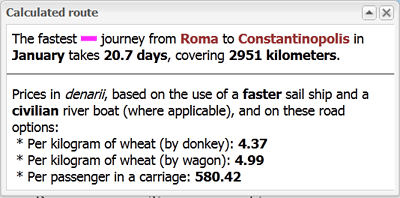This article is more than 1 year old
Roman roads get the web maps treatment
M-III traffic means Londinium to Venta (Winchester) takes 3.7 days
Classical scholars at Stanford University have created a “Geospatial network model of the Roman world” which offers the chance to calculate journey times along Roman roads in much the same way as is possible on Google Maps and other online mapping services.
ORBIS, as the model is known, can calculate journey times between 751 locations in the Roman world. The site draws data from The Barrington Atlas of the Greek and Roman World which has apparently been georeferenced by Cambridge boffins. To calculate voyages on water, the site uses maps of rivers. Sea journeys are also possible, with routes calculated from the Romans' preferred sea routes. Dijkstra's pathfinding algorithm is applied to calculate routes.
The tool even insists that users set the month for a journey, as weather conditions at sea and on land had a major impact on ancient travel times.
It's also possible to chose from a menu of transport options, namely:
- Foot/army/pack animal (mod. Load), mule cart/camel caravan
- Rapid military march
- Ox cart
- Porter/fully loaded mule
- Horseback rider (routine travel)
- Private travel (routine, vehicular)
- Private travel (accelerated, vehicular/horseback)
- Fast carriage
- Horse relay
The app also calculates the likely cost of transporting people and goods across the Roman Empire.

An example of Orbis calculating a journey across the Roman Empire
ORBIS does not aim to be exhaustively accurate. Instead, it's aim is to “improve our understanding of how a large-scale system such as the Roman Empire worked, of the effort it took to succeed in the struggle to connect and control tens of millions of people across hundreds and thousands of miles of land and sea.”
The ORBIS team says the app is built on PostgreSQL 9.0 database with PostGIS 2.0SVN and pgRouting 1.05 spatial extensions, OpenLayers 2.11, Geoserver 2.1.3; the GeoExt and d3 v2 JavaScript libraries, Gephi v0.8.1 graph visualization and the ExtJS 3.4 Javascript framework.
Performance is not slick: our attempts to calculate a journey from London to Winchester did not always work. But the result – a 3.7 day journey across 111 km of roads – neatly illustrates the different timescales of the ancient world.
And that's enough for one Sydney classics academic of El Reg's acquaintance, who after we informed him about the site declared it was just the thing he needed to prepare for a lecture on the Roman economy and trade next week. ®
